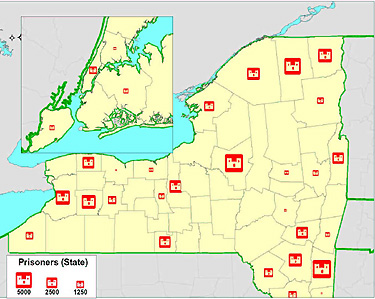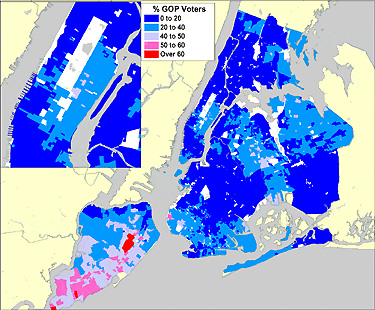Imprisoned In New York
Criminals are among New York City’s most popular exports. According to a recent study, about 44,000 state prisoners, or two-thirds of the entire state prison population, are from New York City. Yet only 3,000 of these inmates are in state-run jails that are actually located in New York City. The rest are trucked up to state-run prisons upstate. While inconvenient to their relatives, their relocation is a huge benefit, both economically and politically, to rural counties upstate – at the expense of New York City.
More Than 100,000 Prisoners
All together, there are some 108,000 people imprisoned somewhere in New York State, according to the 2000 census.
- 6,500 are in federal prisons or detention centers
- 34,000 are in local jails
- 66,000 are in state prisons
Only about 21,000 of these 108,000 were housed in New York City
- 2,600 in federal prisons and detention centers
- 15,000 in local jails,
- 3,000 in state prisons
Many people held in local jails are awaiting trial or serving relatively short sentence. Those convicted of more serious local crimes serve time in state prisons.
Most of those prisons are upstate, as the accompanying map shows.

All prisons built since 1982 have been constructed upstate. There are so many inmates in sparsely-populated rural counties upstate that nearly 30 percent of all new residents in Upstate New York in the 1990s were prisoners, according to a Brookings Institution study. Upstate gained 21,000 new prisoners during the decade, an increase that was accompanied by a growing number of prison staff, as well as inmates' relatives. Upstate has a larger share of prisoners than the nation as a whole -- 1.1 percent of its population in 2000, compared to just 0.7 percent of the U.S. population.”
The Costs
Since the average cost of housing a prisoner in New York is upwards of $40,000 the economic impact of having a prison is enormous. Resources spent on prisoners cannot go for other public activities, so resources are diverted from education, housing and other services to housing prisoners.
The Benefits
Unlike the residents living at-large who surround them they are much more likely male (over 90 percent), black (about 57 percent), and Hispanic (about 30 percent.) Most of upstate New York, of course, is predominantly non-Hispanic white. The only way that such residents are truly welcomed upstate is when they are locked away in cells.
But why are they welcomed even then?
The answer is: they are officially counted as upstate residents.
Services that are provided to them stimulate the local economy, which is frequently in decline.
The prisoners also supply another unique benefit to the upstate region. They allow it to have more voting power than its population would merit if prisoners were not there. Since prisoners cannot vote but are counted in redistricting, they give upstate the benefits of extra people (and cash) without the locality being obligated to address any of their needs. Legally, residency is generally determined based upon both where one is domiciled and the intent to remain there. So a prisoner taken from his home in New York City and counted in an upstate prison, which he expects to leave as soon as he can, is not really an upstate resident. The census could count such individuals where they once lived, as they do overseas military troops. Instead, the census, in effect, gives that population to the upstate New York City rural areas or other areas where prisoners are housed. A new and aptly named web site “Prisoners of the Census” developed by Soros Justice Fellow Peter J. Wagner gives many more details on these impacts.
The impact of this practice in New York State is large. In effect, about 44,000 people are arbitrarily transferred from New York City to upstate, and redistricting for every level of state office is affected. For instance the following Senate districts would be legally underpopulated and need to be redrawn were it not for the prison population:
- District 45 (Betsy Little whose district includes Clinton, Essex, Franklin, Hamilton, Warren and Washington Counties),
- District 47 (Raymond Meier whose district includes Lewis County and parts of Oneida and St. Lawrence Counties); ),
- District 48 (James Wright whose district includes Jefferson and Oswego Counties and parts of St. Lawrence County), ),
- District 49 (Nancy Hoffman whose district includes Madison County and parts of Cayuga, Oneida and Onondaga Counties), ),
- District 51 (James Seward whose district includes Cortland, Greene, Herkimer, Otsego, Schoharie Counties and parts of Chenango and Tompkins Counties), ),
- District 54 (Michael Nozzolio whose district includes Cortland, Greene, Herkimer, Otsego, Schoharie Counties and parts of Chenango and Tompkins Counties) and ),
- District 59 (Dale Volker whose district includes Wyoming County and parts of Erie, Livingston and Ontario Counties)
At the same time several districts in New York City, most likely in Queens, would be over populated, if the prisoners were counted as residing in the city.
Unwilling Sojourners
According to one commentator New York City prisoners are not residents of upstate – they cannot vote or otherwise participate in the local society -- but merely “unwilling sojourners” there. Many are arrested on drug offenses and held for long mandatory minimum sentences. This might help explain why the upstate legislators, most particularly the State Senators from rural upstate districts, are very strong supporters of keeping the Rockefeller drug laws intact.
Once New York City prisoners finish their sentences, they leave upstate and move back to the city with little or no services or reentry assistance beyond that provided by social services and the probation officer.
In sum, New York City residents who become prisoners based in large part on the Rockefeller drug laws are transported upstate to be exploited both economically and politically in largely Republican areas.
Andrew A. Beveridge has taught sociology at Queens College since 1981, done demographic analyses for the New York Times since 1993, and provides expert testimony on a range of cases, including housing discrimination. The opinions expressed are his alone.
The Citizen
Â
|
The Citizen is in another location. If you are not automatically directed to the correct page, click the following link: |
Who Are NYC's Republicans?
As the Republicans prepare for their first-ever national convention to take place in New York City, are they struggling to come up with a welcoming committee of native New Yorkers? Surely, Republican Governor George Pataki will play a part, but what about Republicans specifically from the city? It is true that for almost 10 years New York City's mayor has been a Republican, but both Rudy Giuliani and Michael Bloomberg used to be Democrats, and they won election in part because they were willing to abandon many now-core national GOP positions, including banning abortion and not granting gay people full equality.
The convention could easily give a primetime slot to every Republican elected official from New York City. There are only 13 of them. That includes all three levels of government, federal, state and city:
- Only three of the 51 New York City Council members are Republican.
- Only two of the 65 State Assembly members are Republican.
- Only four of the 25 State Senators whose districts are completely in New York City, are Republican. (Add to that Guy Vellela, who represents a very gerrymandered district that corralled white voters in the Bronx and Westchester County into a district that looks like a white donut around a black center).
- Only one Congressional seat out of the 14 that include New York is represented by a Republican.
(To get to 13, add the borough president and district attorney from Staten Island).
And even most of these GOP office-holders do not represent Republican-majority districts.
Where Do Republicans Live In NYC?
The small number of Republican elected officials is not surprising. Only 13 percent of the 3.7 million registered voters in New York City are registered as Republican, according to the New York City Board of Elections.
The smallest percentage of Republicans is in the Bronx (9.3 percent). Listing the other boroughs in ascending order, they are:
- Brooklyn (12.1 percent)
- Manhattan (14.1 percent)
- Queens (18.1 percent)
By far the largest percentage of Republicans is in Staten Island (37.8 percent). Only in Staten Island are there contiguous areas of Republican strength, as evident in the accompanying map showing the concentration of GOP voters throughout New York City.

Todt Hill, an affluent area of single-family homes, contains the most Republican-majority election districts in the city. The extended area around Todt is also reliably Republican, responsible for electing five of the 13 GOP public officials in the city (a state senator, two assembly members and two council members).
No other area in NYC is so pervasively Republican, not even the Upper East Side. Indeed, even in that affluent enclave (where four years ago zip code 10021 supplied the most campaign funds to both Bush and Gore of any zip code in the United States), Democrats outnumber Republicans.
In Queens there are a few pockets of Republican strength in Glendale, Middle Village, Forest Hills, and Howard Beach as well as Douglaston, Whitestone, and College Point. There are two GOP State Senators and one council member from Queens.
Election districts in New York City with high proportions of GOP enrolled voters, are areas with high proportions of whites living in owner-occupied homes.
How Different are NYC’s GOP Voters from Other NYC Voters?
Republicans in New York City are demographically different from other city adult residents.
GOP members are much more affluent. About 31 percent of them have incomes above $75,000. This compares to only 16 percent of New Yorkers as a whole, according to an analysis of the raw data from a CBS-New York Times poll of New York City completed in June 2003. (Because the number of respondents is only 962, the results reported are approximate.)
Republicans are about half as likely to report that their financial situation has worsened recently--24 percent of Republicans say that, compare to 42 percent of all New Yorkers.
Republicans are more likely to own their own home (47 percent versus 30 percent.)
About three-quarters are white compared to less than half of the rest of the New York City population. Interestingly, though, there is as large a proportion of Republicans who are Hispanic (28 percent) as of New Yorkers in general.
Republicans are more likely to be between 45 and 64 years old than the population as a whole (37 percent versus 27 percent.), and just about as likely as the population as a whole to have kids living with them (35 percent.)
They are more like to identify with a religion, 81 percent compared to 76 percent. While 57 percent of New York City Republicans are Catholic, only 36 percent of non-Republican New Yorkers are Catholic; similarly 14 percent of Republicans they are Jewish compared to 8 percent of the rest of New Yorkers.
But Republicans in New York are just about as likely to be in a union or have a union member in the family--26 percent versus 25 percent -- and even more likely to have a municipal worker in the family--25 percent versus 17 percent.
And Republicans are more likely to smoke -- 29 percent versus 19 percent.
Andrew A. Beveridge has taught sociology at Queens College since 1981, done demographic analyses for the New York Times since 1993, and provides expert testimony on a range of cases, including housing discrimination. The opinions expressed are his alone.




